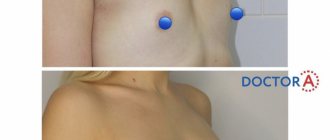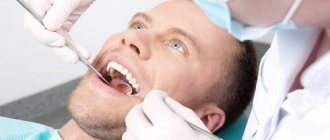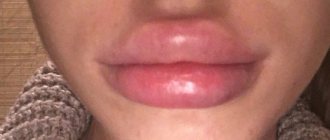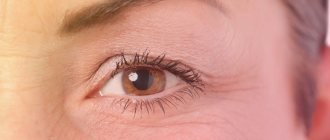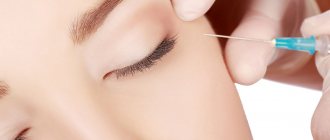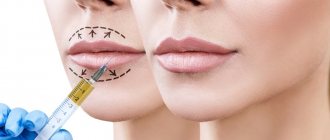The thin, sensitive skin around the eyes begins to undergo age-related changes faster than other areas of the face and body. With age, wrinkles begin to appear in the area around the eyes, eyelids become drooping, the corners of the eyes droop, and bags and “tear trenches” appear under the eyes. Various external factors, such as excess sun or poor nutrition, can accelerate skin aging and hasten the appearance of the first changes.
To correct defects caused by skin aging or individual characteristics, it is possible to seek the help of a plastic surgeon. Blepharoplasty surgery can eliminate a number of visual imperfections, rejuvenate the look and improve the overall aesthetics of appearance. Like other types of surgery, eyelid surgery has its own characteristics, advantages and disadvantages.
Types of blepharoplasty
In plastic surgery, there are various methods of eyelid plastic surgery, differing in the area of treatment, purpose, method of access, and so on. Classic correction is performed on the upper eyelids and is often used to get rid of drooping eyelids. Indicated not only for age-related changes, but also for individual features of the facial structure.
Singapuri, or Asian eye surgery, is also performed on the upper eyelids. Patients with characteristic features of the Mongoloid race who want to change the shape of their eyes, making it closer to Caucasian, turn to the help of such correction. To do this, a fold is formed on the eyelid and the epicanthus is corrected.
Lower blepharoplasty helps get rid of bags under the eyes, tear troughs, and hernias. Circular combines the features of both upper and lower correction. With the classic approach, the incision is made in the natural fold of the eyelids, with the transconjunctival approach - on the inside of the eyelid, on the mucous membrane.
The surgeon selects a technique based on the result the patient wants to get.
Non-surgical methods for correcting ptosis of the upper eyelid
On the Internet you can find a lot of different tips and methods that are designed to eliminate or at least reduce eyelid ptosis. Some of them actually have one effect or another, others are useless at best.
Laser resurfacing
The most pronounced effect of skin reduction and eyelid lifting is achieved by CO2 laser resurfacing. The procedure is performed under local anesthesia and the recovery period takes 6-7 days. It is possible to combine plastic surgery and laser resurfacing under one general anesthesia. A mandatory requirement during rehabilitation is long-term use (at least 6 months) of sunscreen.
Botulinum toxin injections
The introduction of drugs into the area of the edges of the eyebrows provides the so-called “flying eyebrows” effect, which simultaneously smoothes out the folds on the eyelids and makes the look more open and refreshed. However, such a measure is not suitable for every type of face, in some cases it weighs down the image and makes it unnatural.
Thread lifting
The technique involves introducing threads with notches under the skin, which tighten sagging areas and hold them in the desired position. Unfortunately, in the temporal region the tissues are not very dense, which makes fixation difficult and makes the effect of the procedure short-lived - only up to 3-4 months.
Contour plastic
It consists of injecting special fillers based on hyaluronic acid under the skin in the eye area. By filling the space, such drugs smooth out wrinkles and circles under the eyes, but they are ineffective against the overhanging eyelid. And the effect does not last long - up to 6 months.
Makeup
Properly selected decorative cosmetics and the ability to apply them correctly can disguise even quite complex defects on the face, for example, scars, excessive length or width of the nose, the shape and volume of cheekbones or lips. Unfortunately, such measures are ineffective in relation to the skin that appears on the eyes and can only visually reduce the fold or adjust the height of the outer corner of the eyes.
It is important to understand that these correction options only help in cases with minor defects and structural features. They are not able to eliminate serious congenital or age-related problems; only surgical intervention will help.
Indications
In most cases, there are no medical reasons required for blepharoplasty. As a rule, the surgeon makes the decision on the appointment, guided by the wishes of the patient himself. Indications for surgery are rather aesthetic:
- the presence of wrinkles,
- drooping eyelids,
- drooping corners of the eyes,
- folds on the skin,
- excess skin, etc.
- bags under the eyes,
- tear troughs and so on.
In rare cases, certain defects may be caused by congenital characteristics, the result of injury, or a hereditary factor. Provided that such a defect affects the state of health, surgery may be prescribed for medical reasons. Usually this prescription is given by an ophthalmologist. This is possible, for example, in the case of a drooping eyelid, which obscures normal vision and affects vision.
Contraindications
Blepharoplasty is not suitable for every patient. Despite its simplicity, eyelid surgery still remains a surgical intervention, and therefore has a number of contraindications characteristic of all operations:
- diabetes,
- problems with blood clotting,
- diseases of the cardiovascular system,
- infection or inflammation
- acute stage of chronic disease,
- oncology.
Blepharoplasty is not prescribed to patients with eye and facial skin diseases. Conjunctivitis, dry eye syndrome, and high intraocular pressure will be a reason to refuse correction. If the disease is temporary and curable, surgery is possible after eliminating the contraindication. In case of persistent diseases or problems, plastic surgery is, unfortunately, excluded.
Benefits of the operation
The main advantage of blepharoplasty is the result achieved by an experienced surgeon. Modern correction techniques can effectively get rid of most age-related changes and make you look younger visually, making your look fresher and more open. For people who are dissatisfied with their appearance, plastic surgery is an excellent opportunity to change their face and achieve their aesthetic ideal.
The advantages also include the simplicity and accessibility of the operation itself. Eyelid correction can even be performed under local anesthesia, depending on the volume, complexity and type of work. Compared to other types of plastic surgery, blepharoplasty has a lower price, so it is accessible to a large part of the population.
Blepharoplasty is a simple but effective correction.
Another plus is easy rehabilitation. You can leave the clinic on the day of the operation. In the first weeks after the intervention, you will have to observe a number of restrictions, but the return to normal life occurs quite quickly.
What causes this external feature?
There are several criteria:
- The upper eyelid is considered to be drooping if, with the eyes open, its lower edge covers the iris by more than 2 mm.
- If the skin of the eyelid has descended onto the eyelashes, and in fact, is trying to block the field of vision from above.
- An indirect sign is the constant tension of the frontal muscles, in an attempt to raise the eyebrows and along with them the eyelids. This leads to creases (deep wrinkles) on the forehead.
That is, with severe blepharoptosis, both appearance and vision suffer.
There can be several reasons for drooping upper eyelids:
- Age-related changes. Over the years, the skin becomes less elastic and sags. The number of elastic and collagen fibers decreases. Facial muscles weaken.
- Genetic predisposition. Associated with hereditary characteristics of the shape of the orbital region (deep-set eyes, oriental eyelids, etc.).
- Traumatic injury. Ptosis can form due to scars, cicatrices, or muscle damage.
- Errors in diet. Excessive fluid intake, provoked by spicy, salty or fatty foods, contributes to swelling and the development of ptosis of the upper eyelid. For this reason, it is recommended to limit the consumption of salty, smoked, spicy foods, alcohol, and simply drink plenty of fluids at night.
- Dramatic weight loss. With rapid loss of body weight, sagging skin occurs.
- Fatigue. Excessive workload and constant lack of sleep increase the rate of degenerative (destructive) processes in the skin. This leads to loss of elasticity, firmness, and thinning.
- Insufficient care. The skin around the eyes needs careful care and the use of special products. A regular cream may not cope or may not sufficiently nourish the periorbital (around the eyes) area.
- Allergic manifestations. Among them is swelling of the face of varying degrees of complexity.
Flaws
Eyelid correction also has its disadvantages. These include, for example, the slow manifestation of results. The final result of plastic surgery will not be noticeable immediately. You can talk about summing up the results no earlier than a few months after the surgeon’s work. Some patients are very disappointed by the lack of visible results in the first days after surgery.
Another minus is a number of restrictions. In the first month, you should not play sports, lift weights or tilt your head. You should also not be exposed to heat - baths, saunas, hot baths and hot showers are completely prohibited. It is necessary to protect your eyes from ultraviolet radiation - you will need to wear sunglasses for several months. It is highly recommended not to drink or smoke at least during the recovery period.
In addition, blepharoplasty cannot cope with absolutely any imperfections. For example, correction cannot remove dark circles under the eyes.
How long does it take to heal after upper blepharoplasty?
After the operation, the patient's eyelids are hidden under bandages, but this does not prevent most patients from seeing the result immediately after the procedure.
Bruising and swelling are the first things that scare patients after blepharoplasty, but this is a normal reaction of the body to any surgical intervention. The swelling increases in the first couple of days, and in the next two weeks it completely subsides, the bruises disappear even earlier. The skin on the eyelids is very thin, so it heals quickly, and after two weeks patients are allowed to use cosmetics.
Thin scars after blepharoplasty become barely noticeable 1-2 months after the procedure, and after six months there is no trace left of them.
In the first week after blepharoplasty, you should treat your eyes very carefully - hide them from exposure to sunlight under dark glasses, and do not wet the operated area for at least 3-4 days after surgery. You should wash with tampons moistened with soft water. To make swelling go away faster, you need to apply ice compresses.
Complications
After each intervention, natural consequences arise. These include the appearance of swelling and bruising in the operated area. This is normal. Seeking help is required if swelling with bruising lasts longer than two weeks, causes pain and discomfort, or increases in size.
In rare cases, more serious complications are possible. The reasons may be the surgeon’s insufficient qualifications or errors during the operation, the patient’s failure to comply with recovery rules, or the individual characteristics of the body. The first two reasons can be prevented - it is enough to choose a high-quality clinic with experienced specialists, and during rehabilitation carefully follow the doctor’s instructions. In the third case, it is most difficult, since even a very experienced surgeon cannot predict individual characteristics and reactions. Fortunately, complications of this kind are very rare.
Non-surgical ways to solve the problem
How to remove drooping upper eyelids at home? This can be done if the ptosis is not too noticeable. The choice of correction method depends on the cause of the impending century.
Among the most common methods:
- Massage. Aimed at improving blood supply to the periorbital zone. It is used for age-related changes and a tendency to edema. The most common techniques are light tapping, stroking, and pressing.
- Exercises. Regular exercise helps strengthen the eye muscles. These are circular movements of the eyeballs, focusing the gaze on near and distant objects, alternate opening and closing of the eyes, blinking, raising the eyebrows.
- Taping. A modern technique involving the application of tapes (cotton-based adhesive tape) to problem areas. The procedure helps to temporarily tighten the desired areas.
- Injection cosmetology. These are primarily botulinum toxin injections. The mechanism of action is associated with a blockade of neuromuscular connections. This lifts the eyebrows and tightens drooping eyelids. To disguise ptosis, the introduction of mesothreads and hyaluronic acid into problem areas is also used. The main disadvantage of the method is the fragility of the results obtained. The effect lasts for several months and gradually fades away.
- Use of care products. These include creams, gels, masks around the eyes containing hyaluronic acid, vitamins, and nutrients.
- Folk remedies. Among them are compresses made from cucumber pulp, raw potatoes, and herbal decoctions. They also help temporarily get rid of swelling.
- Makeup. Skillfully used cosmetics can visually make the look more open.
Using the above methods you can temporarily correct only a small defect. With severe ptosis, only surgery can really help.

